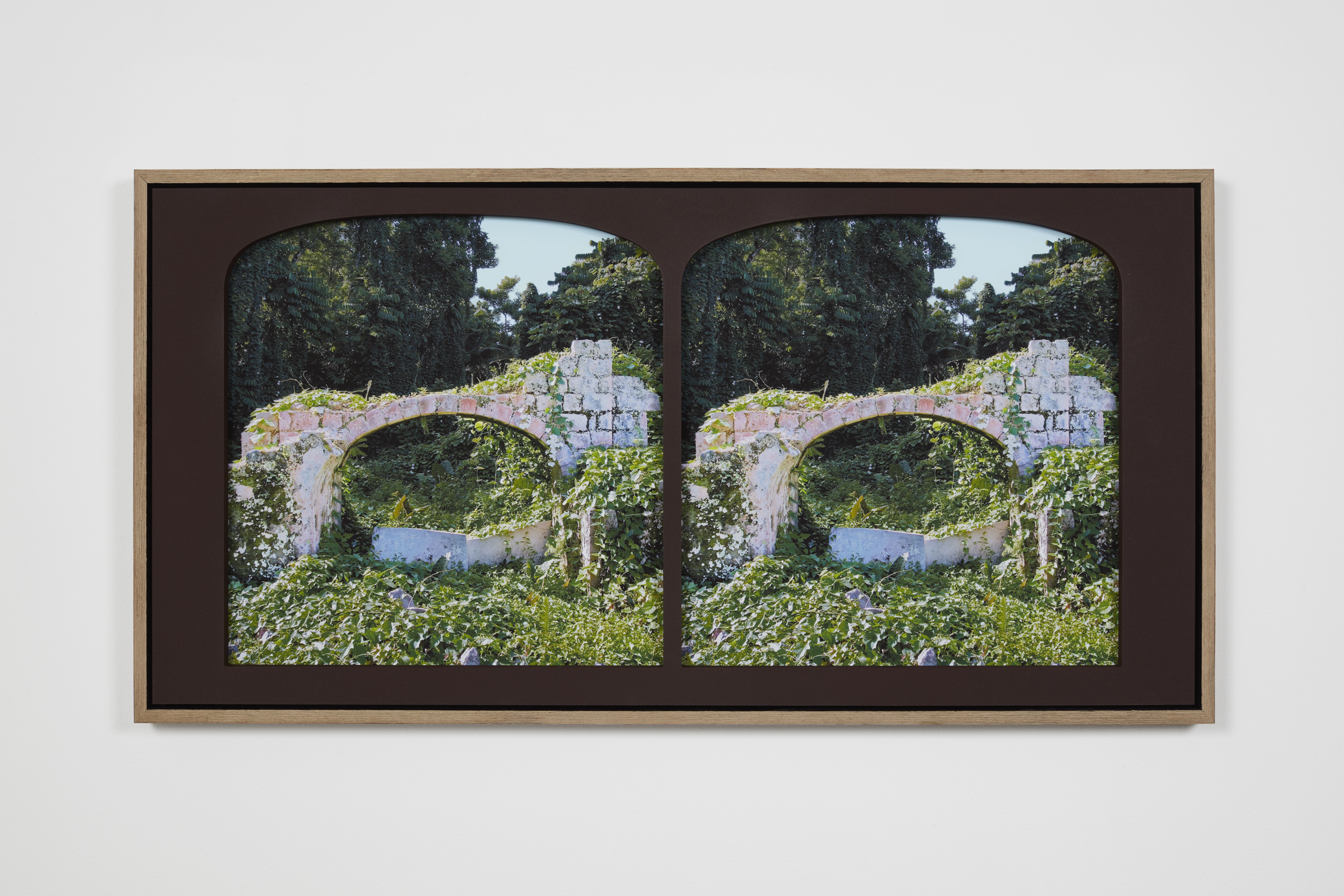Mining Meaning: Jamilah Sabur at Nina Johnson

By Monica Uszerowicz
A photograph of lush, dense foliage encroaching on a dilapidated stone archway anchored “DADA Holdings,” Jamilah Sabur’s contemplative second exhibition at Nina Johnson in Miami. Printed on cotton rag paper, the image, titled Cockpit Country (British Army base 1728–1795), 2021, captures a former British military site in Jamaica. The work is presented as a diptych with two prints of the same image in rounded frames; the format recalls the Victorian stereoscope, an optical device that combined nearly identical photographs to render an apparently three-dimensional effect. By invoking the stereoscope, Sabur casts the viewer as an outsider, romantically gazing at or coolly assessing this locale.
“DADA Holdings” was presented in tandem with Bulk Pangaea (2021), Sabur’s video work commissioned for Prospect.5 in New Orleans. That project, which includes images of Jamaica’s Cockpit Country region (the aforementioned photo is a film still), was shot there and in Louisiana, and takes the NASA Michoud Assembly Facility complex as its starting point. Sited on a onetime sugar plantation owned by French slaveholder Antoine Michoud, the building was constructed in the 1940s for the wartime production of ships and then of cargo planes. Curious as to why it was still named for a figure like Michoud, Sabur investigated the current and historic activities at the site, which involved researching the materials used in building aircraft. This sparked the artist’s interest in bauxite, which is globally mined and refined to make aluminum. Sabur’s research prompted her to seek out bauxite sources, leading her to the mines in Jamaica, the country of her birth, from which ships carrying the stone arrive regularly in Louisiana ports. She saw parallels between the British colonization of Jamaica and the mining of bauxite there today; both forces have exploited the Jamaican landscape and employed similar trade routes, and national militaries led the construction of both the ruins in the photograph and the Michoud NASA facility.
Sabur often explores a country’s history by searching for the points where borders become blurry or meaningless. Bauxite mining and exportation have taken place in Jamaica for decades, to devastating effect. The extraction process involves deforestation and biodiversity reduction, as well as air, water, and soil pollution—the dust can settle in the back of the throat. The government’s push to move operations into Cockpit Country—an ecologically fragile region that includes the partially autonomous village of Accompong, a longtime Maroon community—is widely contested, due to the operation’s location in an officially protected area. (The current administration granted Noranda Bauxite Limited the license to mine in the area at the beginning of this year, after much deliberation; they also agreed to slash the total minable land from more than 20,000 acres to roughly 3,000 acres.)
Sabur relates this conflict to a larger history of land exploitation: one of the most striking works that was included in the show, In This Act (2021), features a diptych of the sharp stalagmites of Jamaica’s Windsor Great Cave, positioned on a canvas above a stenciled paragraph from the country’s 1947 Mining Act. Passed when the country was still a colony, the legislation outlines procedures for prospecting and mining in Jamaica, discussing its minerals as mere resources without acknowledging the industry’s ecological and social ramifications. The selection of this excerpt—which defines the term “to mine”—feels rueful, a reminder of how the verbiage of the State (or, in this case, the Crown) enables significant undertakings within its self-claimed borders. The text’s placement below an image of the cave—likely named for Lord Thomas Hickman-Windsor, the country’s second English civil governor—makes the cave seem unexpectedly vulnerable.
“DADA Holdings” also contained three of Sabur’s neon works, part of an ongoing project that pairs images with glowing texts. In the selected pieces, each title refers to a different body of water or the corporation named for it (Ust-Luga, Rio Tinto, Nord Stream, all 2021); the neon spelling out each title shares the frame with a cricket player’s shrouded face. The genderless cricketeer is a recurring figure in Sabur’s work; cricket is the world’s second-most-watched sport, and it’s especially loved in former British colonies, including Jamaica. Sabur often dons the uniform herself—adding a hood—in videos and short films, including Bulk Pangaea (in one scene, the player stands in a gravel landscape that suggests either a moon or a mine, alluding to the aluminum spaceship parts likely made with bauxite from Jamaica). In Ust-Luga, Rio Tinto, and Nord Stream, the cricketeer faces the genteel names belying controversial companies (just this past December, multiple local protests forced Rio Tinto to suspend its plan to mine lithium in Serbia). In other words, the uniformed cricketeer watches the way a powerful force might attempt to conceal its intentions and history with the gentle mask of a name; the player also watches the protracted, often invisible route a material might travel, from soil to building to outer space—as if it were being batted across a field in a game of strategy and points. For how long does a material travel before it becomes a product? At what moment does a product become more valuable than an ecosystem, or a life? To whom is it a game?
